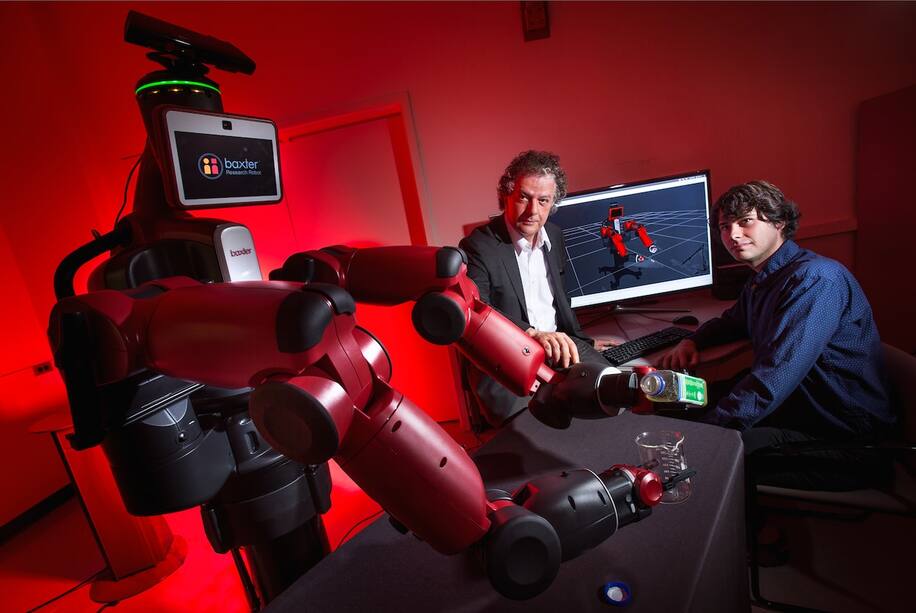 Technology
Technology  Technology
Technology  Misconceptions
Misconceptions 10 Hilarious (and Totally Wrong) Misconceptions About Childbirth
 Weird Stuff
Weird Stuff 10 Warning Labels That Exist Because Someone Actually Tried It
 Health
Health Ten Confounding New Inventions from the World of Biomedicine
 Creepy
Creepy 10 Death Superstitions That Will Give You the Creeps
 Movies and TV
Movies and TV 10 Movies That Get Elite Jobs Right, According to Experts
 Weird Stuff
Weird Stuff 10 Times Real Laws Were Based on Bizarre Hypotheticals
 Animals
Animals 10 Inspiring Tales of Horses Being Human
 Mysteries
Mysteries Top 10 Haunting Facts About the Ghost Ship MV Alta
 History
History 10 Surprising Stories About the Texas Rangers
 Technology
Technology 10 Awesome Upgrades to Common Household Items
 Misconceptions
Misconceptions 10 Hilarious (and Totally Wrong) Misconceptions About Childbirth
 Weird Stuff
Weird Stuff 10 Warning Labels That Exist Because Someone Actually Tried It
Who's Behind Listverse?

Jamie Frater
Head Editor
Jamie founded Listverse due to an insatiable desire to share fascinating, obscure, and bizarre facts. He has been a guest speaker on numerous national radio and television stations and is a five time published author.
More About Us Health
Health Ten Confounding New Inventions from the World of Biomedicine
 Creepy
Creepy 10 Death Superstitions That Will Give You the Creeps
 Movies and TV
Movies and TV 10 Movies That Get Elite Jobs Right, According to Experts
 Weird Stuff
Weird Stuff 10 Times Real Laws Were Based on Bizarre Hypotheticals
 Animals
Animals 10 Inspiring Tales of Horses Being Human
 Mysteries
Mysteries Top 10 Haunting Facts About the Ghost Ship MV Alta
 History
History 10 Surprising Stories About the Texas Rangers
Top 10 Absurd Robots That Scientists Have Actually Built
We are living in the age of robotics. The world today is dominated by machinery and technology. There are many who say we should fear the rise of the robots, that they are destined to steal our jobs or even use their weapons against us. But not all robots are threatening and evil. Some of them are just plain weird.
Across the world, scientists are at work developing all kinds of mind-boggling machinery and bizarre AI. In the last few years alone, roboticists have unveiled a sassy android, a shape-shifting submarine, and a device that allows fish and bees to speak to each other. From cuddle machines to worm-powered Lego, here are ten of the weirdest robots ever built.
10 Futuristic Things AI And Robots Are Already Doing
10 Irony Man, The Sassy Robot
Fans of Douglas Adams will no doubt be familiar with Marvin The Paranoid Android, the depressed if slightly conceited robot from The Hitchhiker’s Guide To The Galaxy. But, instead of a paranoid android, how about a sassy one? A robot that rolls its eyes from time to time and fires off acerbic comments.
Well, scientists from Ausburg University have created just that, after programming one of their latest robots with a sense of irony. The fittingly-named Irony Man is designed to be less formal and more relatable than a typical AI. Unlike most talking machines, which speak in flat monotonous voices, Irony Man is able to reflect real patterns of human speech. So if someone were to say that “Traffic is frustrating,” Irony Man would retort “I love being stuck here” with a sarcastic emphasis on the word “love”.
But why would anyone want to make a smart-mouthed robot? Irony Man’s creators thought that he would be easier to get along with if he was programmed to speak like a real person. And it seems as if they were right. Students who took part in a trial with Irony Man found him to be more endearing than a standard machine. However there are still concerns over his lack of tact. Irony Man can use sarcasm but is unable to judge if it is appropriate, so he sometimes comes across as a little obnoxious.[1]
9 Skybot F-850, Russia’s Robot Astronaut
Skybot F-850 is an android astronaut, a fully-automated machine designed by the Russian space agency for life on board the International Space Station (ISS).
Engineers spent five years developing and preparing Skybot for the challenge of going into space. The six foot android is built from sturdy materials to survive the blast into zero-gravity, and is specially programmed to stop it from inadvertently damaging the space centre.
In summer 2019, the mechanized cosmonaut spent two weeks working on board the ISS as a “social companion” to the human crew. During its time in orbit, Skybot was able to converse with its fellow astronauts, answering their queries and keeping them amused with the odd joke. The android was even able to fly itself to the space station, taking command of a Soyuz spacecraft and monitoring its conditions as they entered zero-gravity.
As Alexander Bloshenko, executive director of the Russian space agency, told reporters: “Future generations of such robots will solve tasks that are potentially of special risk for humans, such as extravehicular activities and telemetry operations on solar system bodies.”[2]
8 Lovot, The Cuddly Robot Who Helps Combat Loneliness
In our modern age, when everyone seems to be moving at a hundred miles a second, loneliness can be a major issue. For those who struggle with companionship, Japanese startup Groove X has designed Lovot – a little furry robot who comforts people in need of a friend.
Lovot is an affable machine, a pint-sized pal that quickly warms to its owner. For those in need of a good hug, its fleecy “skin” is designed to be warm and easy to cuddle, and the robot is always happy for some close personal contact. Over time, Lovot’s emotional bond is said to grow stronger as it starts to learn its owner’s face and comes to meet them when they get back home.
Whether it is healthy to try and cure loneliness with artificial friendship instead of human connection is an interesting question. But, whatever your opinion, Lovot has been selling in Japan for over a year now. And developers say that, with future investment, it might soon be on its way to the US as well.[3]
7 Robot Translator For Fish And Bees
In 2019, scientists at the Swiss Federal Institute of Technology Lausanne built a machine that allows fish and bees to talk to each other. The researchers created a robot translator that can send messages back and forth between a group of zebrafish and a swarm of honeybees. To really challenge themselves, the scientists decided to conduct their experiment from different countries. The fish were at one location Switzerland. The bees were miles away in neighboring Austria.
The robot translator issued commands to each species then translated their responses into signals for the other group. So the fish might be shown a color or tail movement, which influenced the direction of their swimming. This would then be translated into a vibration or a change in temperature, which caused the bees to move to a different area. The bees’ motion would then be translated into a signal for the fish, and so and so forth. To start with the experiment was absolute bedlam, but after 25 minutes of confusion the animals began to respond to their robotic stimuli.
Although this might sound like an absurd experiment, communicating with animals has many real world applications, like stopping birds from flying over airports or warning bees about pesticides on plants.[4]
6 Lego Robot With The Brain Of A Worm
Imagine mapping out the entire human brain, taking all of the pulses and electrical signals, and then uploading them into a machine. You could become immortal, in theory, living forever as a digital being. If that sounds like an ethical quagmire then you will be pleased to hear that scientists are a long way from achieving anything that sophisticated. But they have managed to pull off a similar feat using a tiny worm and some Lego.
In 2014, neuro-robotic researchers mapped out the brain of a small ringworm, all 302 neurons, and turned it into a digital simulation. Simulating an entire brain is remarkable in itself, but the scientists decided to feed their virtual brain into a Lego robot. The Lego bot was hardly sophisticated; it had a sound sensor for a nose and two motors to act as its motor cortex. But, with a little tweaking, the virtual worm brain was able to control the robot, driving it around a test station and stopping it from bashing into the walls.
Eventually the researchers hope to be able to simulate not just the brain but an entire worm, building the world’s first digital life form.[5]
Top 10 Creepy Robots With Good Intentions
5 China’s Robot Traffic Police
In 2019, China began using robots to keep control of its roads. The Handan Public Security Bureau now employs three styles of robot that help their existing officers maintain order. The three robots are similar in design, but they each carry out very different functions.
One type, the road patrol robot, seeks out and documents any criminal behavior on the roads. Its designers have even given it a uniform and hat to look more like a human officer. Another, the accident warning robot, informs nearby drivers that the police are dealing with an incident. The third type is the advice traffic robot, which helps direct drivers at vehicle management stations, whilst also keeping an eye out for security risks.
People in China are no strangers to robot police officers. In 2016, authorities started to use a security robot in Shenzhen Airport, and in 2017 an E-Patrol Sheriff was introduced in Henan.[6]
4 Julia, The Robot Who Taught Herself To Cook

Leaning to cook is a difficult task. To train as a professional chef takes years of study at culinary school and a huge dedication to learning the craft. But what if there were an easier way? What if, instead of spending years training, you could ask a robot to teach itself to cook and then have it make a meal for you?
Researchers at the University of Maryland are working on exactly that. Unlike most machines, their robot – called Julia – has no need for step by step instructions. Instead she has taught herself to cook by watching videos on YouTube and copying what she sees.
Right now Julia is nowhere near Michelin star level. Her culinary skills are limited to a few basic activities. But even that is an achievement. Tasks that might seem simple for you or me, like pouring a glass of water, are actually quite challenging for a robot.[7]
3 Robot Fish Powered By Synthetic Blood
It sounds like something out of cheesy sci-fi horror movie: a robotic fish that runs on the power of blood. But in reality a mechanized fish is no villain. In fact it could turn out to be the future of energy-efficient robotics.
Energy storage is one of the main limitations in robotic design. Most devices either run out of power very quickly or lug around heavy batteries which slow them down. In contrast, the robot fish runs on a hydraulic fluid – similar to blood inside a real fish – and receives enough power to swim upstream for 36 hours. Speed, however, is not the robot’s strong point. It trudges along at a mere 1.5 body lengths per minute.
Nonetheless, the robotic fish is a remarkable feat of engineering. As Professor Rob Shepherd, one of the key developers at Cornell University, told journalists: “We want to take as many components in a robot and turn them into the energy system. If you have hydraulic liquids in your robot already, then you can tap into large stores of energy and give robots increased freedom to operate autonomously.”[8]
2 Rwanda’s Healthcare Robots Fighting Coronavirus
In the Rwandan capital Kigali, robots are leading the fight against coronavirus. The use of mechanized practitioners at treatment centers in Gatenga and Kanyinya means staff spend less time around covid-positive patients, and are therefore less likely to contract the disease themselves.
The mass breakout of coronavirus has forced healthcare experts everywhere to think outside the box for ways to tackle the pandemic. Designed by Zorabots, the five robots are able to keep track of patients’ vital signs, convey video messages and correct people for not wearing their masks properly. One of the androids is currently stationed at Kigali International Airport screening up to 150 people a minute.[9]
1 Aquanaut, The Shape-Shifting Submarine
The Transformers were one of the most popular franchises of the 1980s, and one of the most terrible film series of the 2000s. Transformers, for anyone who is not aware, are autonomous robots that can transform themselves into motor vehicles. These shape-shifting wonders captured the imaginations of children over the decades, but they always seemed like a remarkable work of fiction, something that could never be created for real. Until recently, that is.
Now scientists at Houston Mechatronics Inc. have developed a real-life Transformer – a semi-humanoid robot that can convert itself into a submarine. They named it Aquanaut. The creators wanted to build a machine that combined the freedom of a long-distance underwater vehicle with the precision of a remotely-operated bot.
Built on a $23 million budget, Aquanaut is mainly designed for use on deep sea oil and gas pipelines. The robot begins its descent in streamlined “submarine mode”, diving steadily through the water until it finds its target. After that, it begins its transformation. The top of the hull lifts up, and a head and two long arms are unfurled for work on the pipeline. As well as its metamorphic abilities, Aquanaut is carrying a range of sophisticated equipment. Its head has been fitted with a 3D sensor, stereo cameras, and a sonar system.[10]
10 Interesting Facts About The Rise Of Sex Robots








